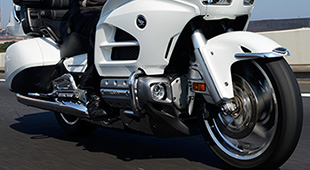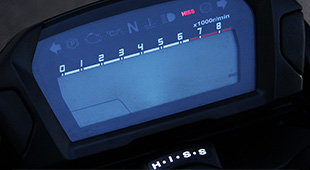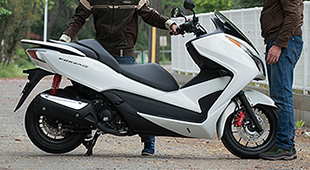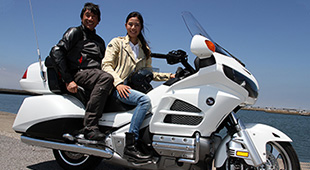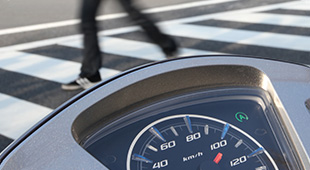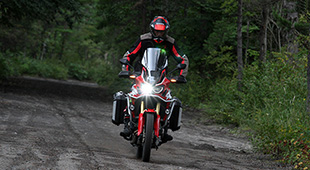Tech Views — Vol. 9 G Switch and Selectable Torque Control
Interview (2/2)
Q1. Could you tell us about the G Switch? Why did you think a G Switch would be required on DCT models?
Ito: For the on-road version we introduced a delay of only a fraction of a second so that clutch operation would hardy be noticeable in the bike’s actual movement, even if the throttle were operated in a somewhat rough manner. The idea was to smooth out the first peak of drive force produced by the engine as the clutch hooks up in order to reduce its impact. However, for the Africa Twin we figured that more experienced off-road riders would prefer quicker throttle response, so the clutch control was reset to more instantly respond to rider inputs.
Q2. How did you manage to apply on-road riding comfort to off-road riding?
Ito: After we decided to create a DCT version of the African Twin, we did some off-road testing with a conventional DCT-equipped bike in the initial development stages to confirm its compatibility. Later, when we used the DCT version of the Africa Twin in actual off-road riding, we could feel a slight delay in response when turning the throttle quickly to raise the front end or slide the rear wheel. This we found was because the DCT till then had been designed primarily for more comfortable on-road riding. Therefore, the G Switch was added to provide clutch operations more in tune with off-road riding.
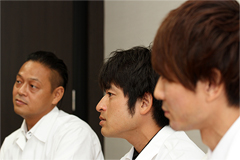
Q3. How were the setups created?
Seo: Since riding skills differ greatly, even among the individual members of the development team, we proceeded with a plan of asking as many members as possible to offer up their opinions. We also sought feedback from people both inside and outside of the development team, and created setups to better match each level of off-road riding ability.
Q4. What sorts of roads did you base the settings on?
Seo: We confirmed operation over a wide range of off-road surfaces, but what we felt were particularly important were gravel roads like those often found on woodland trails.
Q5. Why did you focus so singularly on off-road riding?
Ito: We assumed that most Africa Twin users would already be actively engaged in off-road riding. So, we decided that it was crucial to offer operation that provides a sense of ‘uniformity’ while riding off-road, and essential that the G Switch provide the most appropriate clutch operation for off-road riding. Further, if the G Switch were turned on while riding in D (Drive) mode, users might be confused by the very wide range of choices, including the S (Sport) mode, since the machine determines on its own that it is riding off-road, and the DCT’s shift schedule would change accordingly. One way of coping with this problem was to include an off-road mode. However, on the Africa Twin, to enable riders to enjoy tuning part of the electronic control themselves, we made the DCT’s S mode operate in 3 steps, and the effective degree of Selectable Torque Control also operate in 3 steps, a setup that better satisfies rider sensibilities.
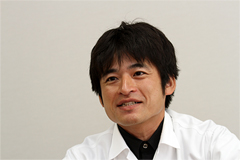
Asuka Ito
Q6. How does the D mode change when the G Switch is turned on?
Ito: Normally, when riding on paved roads in D mode, the speed selection schedule is set so that gear shifts up to 6th are done at speeds of 56 – 58km/h. When the G Switch is turned on, the bike determines that it’s riding off-road, and even when in D mode, the transmission only shifts up from 4th to 5th at higher speeds of around 59 – 61km/h.. Moreover, to facilitate handling in tight corners, it’s been set so downshifts from 3rd to 2nd or 2nd to 1st are delayed to remain in the same gear for as long as possible.
Q7. How can the G Switch’s greatest differences and benefits be best experienced?
Ito: What we regarded as most important is creating a package that enables riders to enjoy riding without feeling uneasy, like the MT (Manual) models, rather than feeling the effects of the DCT while riding. We wanted riders to enjoy the realization that “I’m riding well today.” We then proceeded with the development of the system based on these desires.
The difference between the G Switch’s ON and OFF positions is that if the throttle is repeatedly opened and closed over a short period of time while riding in 1st gear at speeds of around 15km/h, the engine’s response at the instant of opening or closing is noticeably different. Also, I think the effect of the G Switch can be more easily felt during acceleration, deceleration or executing figure eights.
Q8. What is Selectable Torque Control?
Seo: What we call the torque control system detects slippage between the driven rear wheel and the road surface during acceleration to control the amount of engine torque reaching the rear wheel. The force produced when the rear wheel kicks the road surface to power the machine forward is expressed as traction, and this traction varies even on the same road surface depending on bank angle, rider weight transfer or suspension settings. One of the features of the Africa Twin’s Selectable Torque Control is its ability to be selected in 3 steps to match rider skill and user preference.

Satoshi Seo
Q9. What are its ‘Control’ characteristics?
Nakamura: Control is introduced whenever rear wheel slip is detected. Our goal was to allow optimal acceleration with complete peace of mind within that range of control. Based on the VFR800X program, we adjusted the control to best match the Africa Twin’s performance and operating characteristics.
Q10. How does it work?
Seo: When the ignition switch is turned on, the torque control setting always resets to the default value (Level 3). This mode assures safe riding by suppressing rear wheel slip during acceleration, even on wet cobblestone streets or other slippery road surfaces. The settings then proceed from Level 3.
Q11. How did you determine the settings for Levels 2 and 1?
Seo: We first had expert riders run off-road courses with the torque control turned completely off, and carried out data measurements to see how they used the rear wheel slip. Based on that data, we determined the degree of intervention for the other two levels.
Q12. Which parts did you regard as important when performing settings?
Seo: Even when control is enabled, the machine needed to remain rideable. That is to say, would it still be possible to carry out the functions of riding as intended? We attached great importance to this. If torque is overly suppressed by the control, torque output would be reduced to virtually nil even though the throttle is wide open, making it really difficult to ride the bike off-road. So, we carefully set the torque to find a suitable skid rate and managed to realize controllable performance without spoiling the rider’s overall sense of security.
Q13. In developing the new Africa Twin, did you attempt or encounter anything new?
Nakamura: If anything, that would have to be achieving the smooth control of the parallel twin’s fuel injection cut system. Honda already had torque control systems for throttle-by-wire models like the VFR1200X, and since they control the throttle electronically, smooth torque control was also possible. However the Africa Twin uses a conventional cable-type throttle for more direct throttle control, so the torque control had to operate by way of a fuel cut system. Although a system like that was already being used on the VFR800X, this was an entirely new application, especially since the number of cylinders was reduced by half.
We began development using the VFR800X’s system as a base. In the case of the Africa Twin, with its engine’s 270° offset dual-pin (or ‘phased’) crankshaft, unless the fuel injection is precisely controlled, more jerkiness in its operation would be noticeable than in the case of a 4-cylinder engine like the VFR’s, and smooth traction would be difficult to achieve. Because of this, in developing the Africa Twin’s unique fuel injection system it was even more important to ensure precise timing of the fuel cut and mapping of the fuel injection patterns so riders could feel the traction building smoothly.
With other existing systems we experienced difficulties in conditions where the characteristics of the bike and engine change. For instance, when wanting to reduce torque, at which interval should the output be cut? The Africa Twin’s settings started out with making that issue clear.

Masanori Nakamura
Seo: Even when leaning out fuel delivery by 50 percent, two different patterns had to be considered: one was ‘Injection ON-OFF-ON-OFF’ and the other ‘Injection ON-ON-OFF-OFF.’ Both conditions reduce the volume of fuel injected by 50%. To determine the correct pattern, we carried out testing to find out which was smoother.
Nakamura: When the torque control is activated and the fuel cut intervenes, sometimes it can’t infer a correlation from the throttle opening or engine speed alone, so the DCT’s clutch control was designed separately.
Ito: For example, when starting from a dead stop on a slippery road surface, the torque control intervenes by leaning the volume of fuel injected. Based on engine speed and throttle angle signals, the DCT calculates when it must connect the clutch from the amount of torque output present.
On the other hand, the torque control monitors and controls rear wheel slippage by momentarily intervening to cut the fuel supply to the engine, making its calculations separate from the engine speed and throttle angle and, taking into consideration the fact that the engine could stall, engaging the clutch more gently than usual.
Seo: The DCT is designed to enable riders to more easily and confidently ride over slippery road surfaces and rough terrains, even using its default settings. It is also possible for more aggressive riders to ride with it switched completely OFF. Since the Africa Twin’s basic off-road riding performance is already quite good, I’m sure it would still be fun to ride with its automatic gear selection left OFF. As an electronically-controlled system, the DCT’s mechanicals are quite simple. But since it was carefully designed to the most minute detail, I believe a wide range of riders can fully enjoy everything it has to offer. Through every stage of development we compared it against other models, and we’re confident that the Africa Twin is the best of them all by far.
Q14. In what sorts of conditions should the torque control be tested in order to better understand its characteristics?
Seo: Since the torque control is rarely activated on paved roads, I’d suggest trying different maneuvers on gravel roads or fire trails, and modulating the way you open the throttle.
Armed with this advice, I headed for an off-road course to test the effects of both the G Switch and the Selectable Torque Control system.
- Top
- Interview
- Impressions

